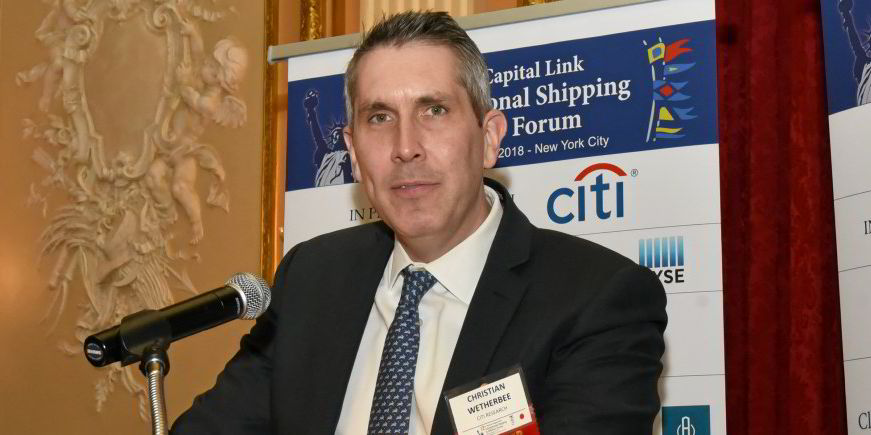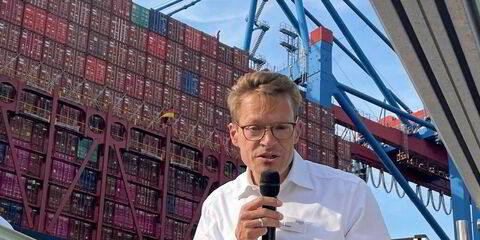A decade has passed in the blink of an eye, former Deutsche Bank shipping analyst Amit Mehrotra reflected in a conversation with Streetwise this week as he prepared to take a new research job outside the sector.
One of Mehrotra’s first memories of taking the bank’s shipping gig in 2014 was getting a phone call from TradeWinds, asking him to confirm the news.
Mehrotra was a bit wide-eyed to the ways of shipping then, but leaves for a new industrials job at UBS as a grizzled maritime veteran.
The good and the bad
As an outspoken researcher, he has formulated a few opinions — good and bad — on what he has seen over the past 10 years.
Mehrotra took a break from gardening leave this week to voice comments that were partly praising, partly critical, but by no means disrespectful, of a sector that has come to fascinate him.
“Covering shipping has been one of the biggest blessings for my professional career,” he said from his Atlanta home office.
“It was the first opportunity that led to me being able to cover transport stocks more widely as a group. I owe a massive debt of gratitude to the industry. I don’t think it’s goodbye. I think it’s goodbye for now.”
Now about those observations — and first the good part.
Mehrotra entered an industry in 2014 that was still sorting the consequences of a massive inflow of private-equity capital.
“The orderbook was 50% of the fleet, and there were all these unfunded capital-expenditure requirements,” Mehrotra recalled.
“Fast-forward 10 years and it’s an industry with too much cash and too much equity. It’s a much more fiscally responsible business, and I’d like to think we at Deutsche Bank played some small part in that.”
As Mehrotra observed, it is a different landscape today for shipping and for the publicly listed shipowners that were his speciality, due largely to the extended boom markets that have blessed most sectors.
Owners are rapidly pre-paying debt and largely refraining from — or at least being restrained about — commitments to newbuilding orders.
This has left them flush with cash and in many cases ladling out robust shareholder dividends. Meanwhile, lenders and investment bankers might be compared to the lonely Maytag washing machine repairman in the old US television commercial. He symbolised little demand for his services due to the exceptional reliability of Maytag washing machines.
“The first step in becoming more attractive to investors is to get your capital structure fixed,” Mehrotra said.
Suicide-by-newbuildings?
“To that end, the public sector is in a better position than they’ve ever been in. The industry’s moving in a really great direction.”
We asked Mehrotra whether this is strictly a case of owners having learnt hard lessons, or has uncertainty over future propulsion systems been an artificial curb on suicide-by-newbuildings?
“Well, if there are 10 reasons, I’d say ‘hard lessons’ come in reasons one through nine. It’s not really down to the propulsion technology, although that’s helped,” he said.
For all the good he has to say, you get the sense that there is a “but” coming. And, sure enough, Mehrotra is not shy about delivering on that part either.
The hard truth is that despite its advances, shipping is not investable yet. Not really. Not in the broader context that Mehrotra already has seen through his expanded research into trucking and rails, and not compared to what is on deck as he moves into industrial coverage in even larger companies.
In this wider context, public shipping companies are still too small and wedded to net asset value as a metric to truly join the big boys, or even the bigger boys.
“In shipping, once you get over a market capitalisation of $1bn, you probably begin to get some looks,” Mehrotra said. “In transports like trucking and rails, it’s probably $10bn. In the broader electrical equipment and industrial sector, it’s more like $30bn. So it’s a much broader universe.”
Put another way, Scorpio Tankers was the largest company under Deutsche Bank’s coverage with a market capitalisation of about $4.5bn. When Mehrotra moved into trucking, a smaller company was at about $12.5bn, a larger one about $40bn.

“If you’re a portfolio manager for one of the big funds, you’re not just looking at shipping names. If you can get a 10% return on a $50bn market cap company in another industry, that might look better than a potential 20% return on a $3bn market cap company in shipping,” Mehrotra said.
“The sector lacks the financial scale and maybe even the asset scale to be relevant and attract broad-based interest in the investment market. And if anyone disagrees with me on that, they’re wrong.”
Parting words
The latter comment is classic Mehrotra. And it reflects the type of cocksureness that sometimes brought him into conflict with a management team or two.
One can imagine his face on a dart board in the executive offices of a public shipowner we shouldn’t mention. Scorpio Tankers, cough cough, Scorpio Tankers!
But these things happen in shipping, Streetwise can attest from personal experience.
And there’s no point in dwelling on them, as Mehrotra is moving on to other things. But is that for good?
We’ll leave the parting words to Mehrotra.
“If shipping becomes relevant enough for institutional investors, maybe not,” he said.






